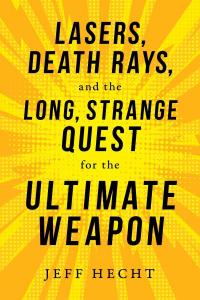
Jeff Hecht, Lasers, Death Rays, Quest for Ultimate Weapon
For this column, NASW book editor Lynne Lamberg asks NASW authors to tell how they came up with the idea for their book, developed a proposal, found an agent and publisher, funded and conducted research, and put the book together. She also asks what they wish they had known before they began working on their book, what they might do differently the next time, and what tips they can offer aspiring authors. She then edits the A part of that Q&A to produce the author reports you see here.
Publication of NASW members’ reports in Advance Copy does not constitute NASW’s endorsement of their books. NASW welcomes your comments, and hopes this column stimulates productive discussions.
LASERS, DEATH RAYS,
AND THE LONG, STRANGE QUEST
FOR THE ULTIMATE WEAPON
Jeff Hecht
Prometheus Books, Jan 8, 2019, $25 hardcover
ISBN-10: 1633884600; ISBN-13: 9781633884601
E-PUB ISBN: 9781633884618
Hecht reports:
Writing about the history of laser weapons was a logical follow-on to decades of covering laser technology, a Reagan-era book on laser weapons, books on the histories of fiber optics and lasers, and dabbling in science fiction. I had collected lots of information and contacts, written some features, and had given a few talks on the history of laser weapons. I could tell there was interest in a book, but I had not done much about it until I hit a slow point in magazine writing and decided to see where I could go with a book proposal.
I did not have an agent at the time, so I asked around. A friend recommended Laura Wood at Fine Print Literary Management. I sent it to Laura, who helped me turn it from a rather geeky and detailed semi-scholarly history into a more compact and marketable book aimed at the general reader.She also pushed me to take a more narrative journalism approach in my sample chapter. I had a perfect story for that; how the Pentagon blew its chance to invent the laser by denying a security clearance to a visionary physicist who had been a communist.
Laura shopped the proposal around and got interest from Prometheus Books and a couple of university presses. We decided to go the commercial route. Once I had the contract, I applied for a research grant from the Alfred P. Sloan Foundation, which was a great help when it came through.
My research files from earlier books and stories were a big help in getting started. I called up some old-timers I remembered and got some great stories from them. My grant paid for archival photo research that yielded some great photos. Oral histories, military histories, two self-published books on death rays, and the archives of The New York Times and Aviation Week were great helps.
My biggest problems were poor time management, falling down research rabbit-holes that did little for the book, and not turning down all other work until the book was done.
Contact info:
- Jeff Hecht, 617-965-3834, jeff@jeffhecht.com or hechtnews@gmail.com, http://www.jeffhecht.com, @jeffhecht
- Blog: https://jeffhecht.com/lasers-death-rays.html
- Book website: https://www.penguinrandomhouse.com/books/576970/lasers-death-rays-and-the-long-strange-quest-for-the-ultimate-weapon-by-jeff-hecht/9781633884601/
- Agent: Laura Wood, 918 269-6317, laura@fineprintlit.com
- Publicist: Jake Bonar, 800-853-7545, jbonar@prometheusbooks.com
NASW members: will your book be published soon? Take advantage of this opportunity for shameless self-promotion. Submit your report for Advance Copy.
Tell your fellow NASW members how you came up with the idea for your book, developed a proposal, found an agent and publisher, funded and conducted research, and put the book together. Include what you wish you had known before you began working on your book, or had done differently.
See https://www.nasw.org/advance-copy-submission-guidelines.
View Advance Copy archives at https://www.nasw.org/member-article/advance-copy.
Thinking of writing a book? If you are a NASW member, you may access a list of more than 150 books and online resources to help you craft your book proposal, find an agent and funding sources, negotiate your contract, learn about self-publishing, publicize and market your book, and more at https://www.nasw.org/article/write-book.
Send book info and questions about book publishing to Lynne Lamberg, NASW book editor, llamberg@nasw.org.
Advance Copy
The path from idea to book may take myriad routes. The Advance Copy column, started in 2000 by NASW volunteer book editor Lynne Lamberg, features NASW authors telling the stories behind their books. Authors are asked to report how they got their idea, honed it into a proposal, found an agent and a publisher, funded and conducted their research, and organized their writing process. They also are asked to share what they wish they’d known when they started or would do differently next time, and what advice they can offer aspiring authors. Lamberg edits the authors’ answers to produce the Advance Copy reports.
NASW members: Will your book be published soon? Visit www.nasw.org/advance-copy-submission-guidelines for information on submitting your report.
Publication of NASW author reports in Advance Copy does not constitute NASW's endorsement of any publication or the ideas, values, or material contained within or espoused by authors or their books. We hope this column stimulates productive discussions on important topics now and in the future as both science and societies progress. We welcome your discussion in the comments section below.





